Peter Betts wrote: ↑Wed Jul 29, 2020 6:38 amMy Boggy Bird ..The only owl I havent seen...In PE italong with the SpottedEagle Owl is the Most common ..Unfortunately Settlers Park is THE Best place to see it in E Cape where it is common in forested areas ..Unfortunately you now have to go there with a crowd and armed protection otherwise your Swarovski Binos and camera and Tripod will be relieved from you by the illegal Bush Dwellers ..Another bit of enjoyment taken away by thugs




Obviously Night would be best time and the Municipal light stands are great places for them to sit I am told by my birding mates but I think I have more chance with saving my life if I were to Live in the Covid ward at our Livingstone Hospital with no PPE's for a month!!
Owls (Family Strigidae)
- Peter Betts
- Posts: 3080
- Joined: Fri Jun 01, 2012 9:28 am
- Country: RSA
- Contact:
Re: Owls (Family Strigidae)
- Lisbeth
- Site Admin
- Posts: 66698
- Joined: Sat May 19, 2012 12:31 pm
- Country: Switzerland
- Location: Lugano
- Contact:
Re: Owls (Family Strigidae)
A VERY FUSSY TENANT: THE AFRICAN GRASS OWL

Rebotile Rachuene, African Grass Owl Project Officer, Birds of Prey Programme – tselanaer@ewt,org.za
Innocent Buthelezi, Field Officer, Wildlife and Transport Programme – innocentb@ewt.org.za
Did you know that there are 12 different owl species in southern Africa? Even if you know about all these species, they can be tricky to identify, as most owls are nocturnal and nest either in thick, long grass, or high up in a tree. Many experts identify the different owls by their call, their behaviour, or their specific habitat. The African Grass Owl (Tyto capensis) makes a soft tk-tk-tk-tk sound in the wing.
One of the species that the Endangered Wildlife Trust (EWT) is working to conserve is the Vulnerable African Grass Owl, a species within the Barn Owl family. Grass Owls are often confused with the Barn Owl (Tyto alba), as they have similar body shapes and markings, or the Marsh Owl (Asio capensis), which occupies similar habitat. Do you know how to tell them apart? Here are a couple of tips in case you don‘t:
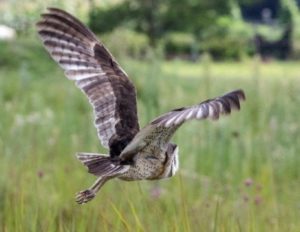
African Grass Owl (Tyrone McKendry)
Both the African Grass Owl and the Barn Owl have heart-shaped, white facial discs, but the African Grass Owl has much darker upperparts than Barn Owls.
Barn Owls are mainly arboreal (tree-dwelling), occurring in a diverse range of habitats – from deserts to moist savanna. They are also often found near human habitation, roosting in caves, hollow trees, and mine shafts (Sinclair 2002).
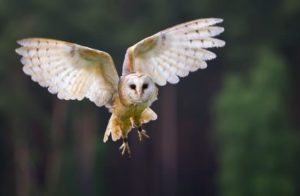
Barn Owl
The African Grass Owl is one of only two ground nesting owls, the other being the Marsh Owl.
Both the African Grass and Marsh owls prefer vleis and marshes, and are more restricted to undisturbed patches of tall, dense grass.
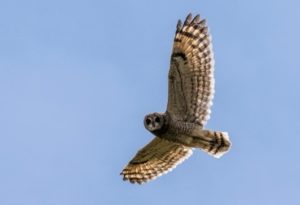
African Marsh Owl (Anton van Niekerk)
Marsh Owls have a dusky (not plain white) face and underparts, and noticeably rounded wings with buff patches at the base of the primaries (Sinclair 2002). The feet of the Marsh Owl do not protrude past the end of the tail, whereas those of the larger African Grass Owl do.
As a nocturnal, ground nesting bird, the African Grass Owl must protect itself and potentially its eggs or young from predation, and so roosts in tall, dense grasses, where it creates dome-shaped structures and tunnels by trampling down the surrounding grass. This technique ensures that the nest is barely visible, but this in turn makes it extremely vulnerable when these areas are ploughed, drained, or burned for agricultural purposes, trampled by grazing livestock, and impacted by mining and development activities. These activities all cause significant damage to active breeding sites, as well as direct habitat loss.
Arson and natural fires contribute to almost 60% of African Grass Owl mortality, and damage to their habitat. In addition to natural predation of the nests by species such as Bush Pig, Black-backed Jackal and Caracal, the nests are also trampled on, or the owls are predated upon, by dogs used for illegal hunting. The threats to their habitat have in some cases forced African Grass Owls to roost in open areas closer to other dangers, such as urban areas and rapidly expanding road networks. It is critical that we not only monitor these threats on population levels, but also identify ways to safeguard these breeding sites from human activities.
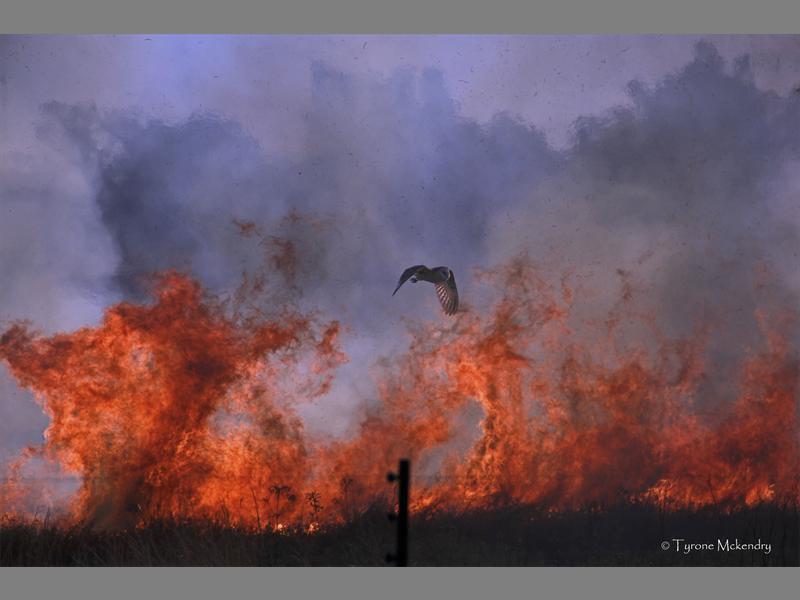
Fire contributes almost 60% of Grass Owl mortality and habitat destruction. Photo credit Tyrone Mckendry
To understand the negative impacts of roads on the African Grass Owl, the EWT’s Wildlife and Transport Programme (WTP) has partnered with the country’s three major toll agencies, Bakwena N1/N4, N3TC and TRACN4. All three toll routes pass through a diverse range of habitats, including urban landscapes, communal land, and agricultural areas. The toll companies’ route patrollers have been gathering road mortality data for the WTP, and owls are among the most common roadkill species recorded. One reason for this is that small rodents are attracted to the road due to truck-grain-spillage, and owls perch on poles by the roadside to predate upon these rodents. The owls may also fly across the road between nesting and feeding sites, or in search of a mate. The African Grass Owl is therefore particularly vulnerable between February and April, during its breeding period, when it is most active.
One way to minimise owl roadkill, particularly of the ground nesters (e.g. African Grass and Marsh owls), is to prevent grain spillage from trucks, and keeping the grass on the road reserves short to discourage these owls from roosting near the road. Another method to reduce owl roadkill implemented in 2015 by the Springbok Branch of SA Hunters was to erect self-feeders away from the road. These perches effectively act as ‘owl restaurants’, designed to attract granivorous rodents to a focal site, away from the roads. This has seen a reduction in owls being killed on roads, but the this needs to be quantified.
Interestingly, due to the imposed lockdown, resulting from the Covid-19 global pandemic, there has been a reduction in roadkill rates due to reduced traffic volumes on roads, as well as the enforced night-time curfew. Reports from local landowners and partners of the African Grass Owl Project suggest that the species has benefitted from these restrictions, with many nests remaining intact. This is indeed great news for this species and demonstrates that there is hope for the conservation of the African Grass Owl. This begs the question – will the lessons learned from the lockdown help us to save this beautiful and charismatic bird species from the negative impact of human activity? The country’s lockdown, which was put in place to prevent the spread of the Covid 19 disease, provides a once in a lifetime opportunity to determine if reduced human presence and their use of roads, can see a return of wildlife to their natural habitats. Could this motivate for our railways to be utilised more to transfer freight so that large trucks are removed from the roads? Only time will tell, and it is critical that we continue to maintain sustained collaborative relationships with our landowners and partners in conserving the African Grass Owl and monitor our long-term conservation impact systematically.
The African Grass Owl Project is proudly supported by the National Geographic Society and the Mafube Coal Mine (Middleburg). Thanks to Bakwena, N3TC and TRAC for their kind support with roadkill data collection.
Remember to celebrate Owl Awareness Day on 4 August 2020!

Rebotile Rachuene, African Grass Owl Project Officer, Birds of Prey Programme – tselanaer@ewt,org.za
Innocent Buthelezi, Field Officer, Wildlife and Transport Programme – innocentb@ewt.org.za
Did you know that there are 12 different owl species in southern Africa? Even if you know about all these species, they can be tricky to identify, as most owls are nocturnal and nest either in thick, long grass, or high up in a tree. Many experts identify the different owls by their call, their behaviour, or their specific habitat. The African Grass Owl (Tyto capensis) makes a soft tk-tk-tk-tk sound in the wing.
One of the species that the Endangered Wildlife Trust (EWT) is working to conserve is the Vulnerable African Grass Owl, a species within the Barn Owl family. Grass Owls are often confused with the Barn Owl (Tyto alba), as they have similar body shapes and markings, or the Marsh Owl (Asio capensis), which occupies similar habitat. Do you know how to tell them apart? Here are a couple of tips in case you don‘t:

African Grass Owl (Tyrone McKendry)
Both the African Grass Owl and the Barn Owl have heart-shaped, white facial discs, but the African Grass Owl has much darker upperparts than Barn Owls.
Barn Owls are mainly arboreal (tree-dwelling), occurring in a diverse range of habitats – from deserts to moist savanna. They are also often found near human habitation, roosting in caves, hollow trees, and mine shafts (Sinclair 2002).

Barn Owl
The African Grass Owl is one of only two ground nesting owls, the other being the Marsh Owl.
Both the African Grass and Marsh owls prefer vleis and marshes, and are more restricted to undisturbed patches of tall, dense grass.

African Marsh Owl (Anton van Niekerk)
Marsh Owls have a dusky (not plain white) face and underparts, and noticeably rounded wings with buff patches at the base of the primaries (Sinclair 2002). The feet of the Marsh Owl do not protrude past the end of the tail, whereas those of the larger African Grass Owl do.
As a nocturnal, ground nesting bird, the African Grass Owl must protect itself and potentially its eggs or young from predation, and so roosts in tall, dense grasses, where it creates dome-shaped structures and tunnels by trampling down the surrounding grass. This technique ensures that the nest is barely visible, but this in turn makes it extremely vulnerable when these areas are ploughed, drained, or burned for agricultural purposes, trampled by grazing livestock, and impacted by mining and development activities. These activities all cause significant damage to active breeding sites, as well as direct habitat loss.
Arson and natural fires contribute to almost 60% of African Grass Owl mortality, and damage to their habitat. In addition to natural predation of the nests by species such as Bush Pig, Black-backed Jackal and Caracal, the nests are also trampled on, or the owls are predated upon, by dogs used for illegal hunting. The threats to their habitat have in some cases forced African Grass Owls to roost in open areas closer to other dangers, such as urban areas and rapidly expanding road networks. It is critical that we not only monitor these threats on population levels, but also identify ways to safeguard these breeding sites from human activities.

Fire contributes almost 60% of Grass Owl mortality and habitat destruction. Photo credit Tyrone Mckendry
To understand the negative impacts of roads on the African Grass Owl, the EWT’s Wildlife and Transport Programme (WTP) has partnered with the country’s three major toll agencies, Bakwena N1/N4, N3TC and TRACN4. All three toll routes pass through a diverse range of habitats, including urban landscapes, communal land, and agricultural areas. The toll companies’ route patrollers have been gathering road mortality data for the WTP, and owls are among the most common roadkill species recorded. One reason for this is that small rodents are attracted to the road due to truck-grain-spillage, and owls perch on poles by the roadside to predate upon these rodents. The owls may also fly across the road between nesting and feeding sites, or in search of a mate. The African Grass Owl is therefore particularly vulnerable between February and April, during its breeding period, when it is most active.
One way to minimise owl roadkill, particularly of the ground nesters (e.g. African Grass and Marsh owls), is to prevent grain spillage from trucks, and keeping the grass on the road reserves short to discourage these owls from roosting near the road. Another method to reduce owl roadkill implemented in 2015 by the Springbok Branch of SA Hunters was to erect self-feeders away from the road. These perches effectively act as ‘owl restaurants’, designed to attract granivorous rodents to a focal site, away from the roads. This has seen a reduction in owls being killed on roads, but the this needs to be quantified.
Interestingly, due to the imposed lockdown, resulting from the Covid-19 global pandemic, there has been a reduction in roadkill rates due to reduced traffic volumes on roads, as well as the enforced night-time curfew. Reports from local landowners and partners of the African Grass Owl Project suggest that the species has benefitted from these restrictions, with many nests remaining intact. This is indeed great news for this species and demonstrates that there is hope for the conservation of the African Grass Owl. This begs the question – will the lessons learned from the lockdown help us to save this beautiful and charismatic bird species from the negative impact of human activity? The country’s lockdown, which was put in place to prevent the spread of the Covid 19 disease, provides a once in a lifetime opportunity to determine if reduced human presence and their use of roads, can see a return of wildlife to their natural habitats. Could this motivate for our railways to be utilised more to transfer freight so that large trucks are removed from the roads? Only time will tell, and it is critical that we continue to maintain sustained collaborative relationships with our landowners and partners in conserving the African Grass Owl and monitor our long-term conservation impact systematically.
The African Grass Owl Project is proudly supported by the National Geographic Society and the Mafube Coal Mine (Middleburg). Thanks to Bakwena, N3TC and TRAC for their kind support with roadkill data collection.
Remember to celebrate Owl Awareness Day on 4 August 2020!
"Education is the most powerful weapon which you can use to change the world." Nelson Mandela
The desire for equality must never exceed the demands of knowledge
The desire for equality must never exceed the demands of knowledge
- Richprins
- Committee Member
- Posts: 75546
- Joined: Sat May 19, 2012 3:52 pm
- Location: NELSPRUIT
- Contact:
Re: Owls (Family Strigidae)
Please check Needs Attention pre-booking: https://africawild-forum.com/viewtopic.php?f=322&t=596
- Lisbeth
- Site Admin
- Posts: 66698
- Joined: Sat May 19, 2012 12:31 pm
- Country: Switzerland
- Location: Lugano
- Contact:
Re: Owls (Family Strigidae)
"Education is the most powerful weapon which you can use to change the world." Nelson Mandela
The desire for equality must never exceed the demands of knowledge
The desire for equality must never exceed the demands of knowledge
- Lisbeth
- Site Admin
- Posts: 66698
- Joined: Sat May 19, 2012 12:31 pm
- Country: Switzerland
- Location: Lugano
- Contact:
Re: Owls (Family Strigidae)

The large eyes and ear tufts are typical of the species
The scops owl is a small nocturnal bird of prey that is highly threatened with extinction due to anthropization and the disappearance of populations of large insects. The Sempach Ornithological Observatory estimates the presence of just 30-40 couples throughout the Swiss territory.
Thanks to its perfectly camouflaged plumage, it blends with the bark of trees and is practically invisible. When disturbed, he stretches his body and moves his head, vaguely recalling the attitude of the owl, and raises his ear tufts, to appear larger and put the attacker to flight.
Even literature was fascinated by this mysterious nocturnal inhabitant of the woods and Pascoli dedicated to him the poem "L'Assiuolo" (Scops Owl) which plays with the verse of this bird to create the rhetorical figure of the onomatopoeia: "The stars shone rare / between the milky mist: / I felt the rocking of the sea, / I felt a fru fru among the bushes; / I felt a gasp in my heart, / like the echo of a cry that was. / The sob sounded far away: / chiù ... "
https://youtu.be/zcVqyAmpJEE
"Education is the most powerful weapon which you can use to change the world." Nelson Mandela
The desire for equality must never exceed the demands of knowledge
The desire for equality must never exceed the demands of knowledge
- Richprins
- Committee Member
- Posts: 75546
- Joined: Sat May 19, 2012 3:52 pm
- Location: NELSPRUIT
- Contact:
Re: Owls (Family Strigidae)
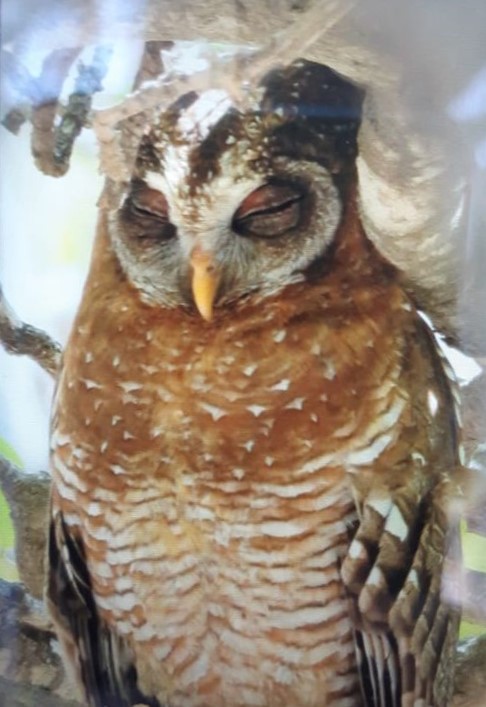
Kruger Sightings
@LatestKruger
Yesterday
Here's one for the birders..
African Wood owl
H4-1, between H12 and Nkuhlu picnic spot.
Near Lower Sabie
5/5
Tinged by Paul Webster
Image
8:50 AM · Sep 26, 2020
Please check Needs Attention pre-booking: https://africawild-forum.com/viewtopic.php?f=322&t=596
- Lisbeth
- Site Admin
- Posts: 66698
- Joined: Sat May 19, 2012 12:31 pm
- Country: Switzerland
- Location: Lugano
- Contact:
Re: Owls (Family Strigidae)
Not an easy one to find 

"Education is the most powerful weapon which you can use to change the world." Nelson Mandela
The desire for equality must never exceed the demands of knowledge
The desire for equality must never exceed the demands of knowledge
- Richprins
- Committee Member
- Posts: 75546
- Joined: Sat May 19, 2012 3:52 pm
- Location: NELSPRUIT
- Contact:
Re: Owls (Family Strigidae)
Please check Needs Attention pre-booking: https://africawild-forum.com/viewtopic.php?f=322&t=596
- Lisbeth
- Site Admin
- Posts: 66698
- Joined: Sat May 19, 2012 12:31 pm
- Country: Switzerland
- Location: Lugano
- Contact:
Re: Owls (Family Strigidae)
"Education is the most powerful weapon which you can use to change the world." Nelson Mandela
The desire for equality must never exceed the demands of knowledge
The desire for equality must never exceed the demands of knowledge
- Richprins
- Committee Member
- Posts: 75546
- Joined: Sat May 19, 2012 3:52 pm
- Location: NELSPRUIT
- Contact:
Re: Owls (Family Strigidae)
I think these are Cape eagle Owls!


SANParks Camdeboo
@SANParksCNP
Camera with flashTony KayCee photographed these two owls within five minutes of one another in #CamdebooNP
10:12 AM · Sep 20, 2021·Twitter Web App


SANParks Camdeboo
@SANParksCNP
Camera with flashTony KayCee photographed these two owls within five minutes of one another in #CamdebooNP
10:12 AM · Sep 20, 2021·Twitter Web App
Please check Needs Attention pre-booking: https://africawild-forum.com/viewtopic.php?f=322&t=596


